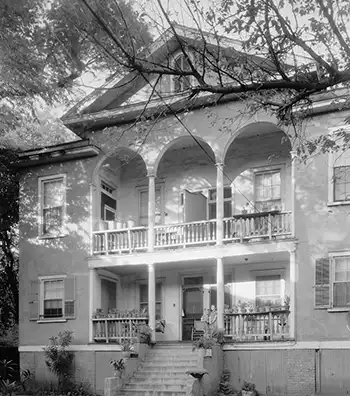If you’re new to the Charleston history scene, there’s a name that should be added to your rolodex of pioneering local women: Henrietta Aiken Kelly. She hoped to make South Carolina famous for a different agricultural venture in the early 20th century and that was after she had already blazed a trail in advancing educational opportunities for women.

A School of Their Own
At the turn of the 20th century, most colleges admitted only male students. Kelly advocated for young women to have the opportunity to earn a degree, too. She was unsuccessful in her efforts to persuade the College of Charleston to admit women, so she founded a college for them — the Charleston Female Seminary (aka Miss Kelly’s School). The private school was located downtown at 50 St. Philip St., just across from the campus of the College of Charleston, where the Simons Center for the Arts now stands.
The school catered to the city’s “most privileged daughters,” embracing not only a classical education but additional coursework in physical education, with the school motto “Mens sana in corpore sano” (A sound mind in a sound body). Kelly urged her students to pursue ways to help others and among her graduates were social activists, missionaries, teachers and nurses, including South Carolina’s first woman doctor, Sarah Campbell Allan and local women’s advocate and suffragist, Sarah Bentschner Visanska.

Kelly’s background was in teaching and she had served as vice principal of the city’s first public school, the Charleston Normal School (later renamed Memminger High School). Classes for her newly formed college were initially held in her home at 157 Wentworth St. before moving in 1871 to the location on St. Philip Street, a house that was designed by the prominent Charleston architect John Henry Devereux.
Silk Dreams
In 1890, Kelly began taking her students to Europe to expand their educational and cultural opportunities. On one of her trips, she visited an old friend from Charleston who was living in northern Italy and was introduced to the silkworm industry there. Because the region’s climate and soil are comparable to that of the Carolina Lowcountry, she envisioned establishing a silk industry at home which could turn the state’s struggling post-Civil War economy around. This was not the first time such a venture had been pursued in the Lowcountry.
Two centuries earlier, Silk Hope Plantation and Mulberry Plantation, both on the Cooper River, had produced silk, but the enterprise was eclipsed by the more lucrative rice industry. There had also previously been two brief episodes of successful silk production in the northeastern states and California in the early and mid-1800s, but an attempt at producing silk in the Midwest had failed due to disease from imported mulberry trees whose leaves comprise the worms’ diet. With the textile industry as the major economic driver in South Carolina in the early 20th century, it seemed to her to be the perfect time to reignite interest in producing silk here. Her plan would offer poor white farmers and sharecroppers a chance to overcome their dire financial straits by running their own businesses. Operating as a family affair, women and children would be part of the work force for these entrepreneurs.
Kelly closed her school in 1896 and, at the age of 52, went to Europe to study sericulture (the raising of silkworms for silk production) alongside proteges of the renowned biologist Louis Pasteur at the Sorbonne in Paris, Geneva and Cambridge. She became an expert on the subject and accused the U.S. government of previously relying on novices who were not properly trained in the biology and care of mulberry worms. In 1899, she solicited the help of South Carolina’s governor and the U.S. Secretary of Agriculture and subsequently obtained federal aid to fund experimental scientific stations to grow different varieties of mulberry trees. Her friends in Italy sent her a thousand trees to plant on two properties they owned in Summerville: Hope Plantation and Rosebank Plantation.
Kelly feared that, as a woman, her ideas might be dismissed so she met with prominent men to sell them on her plan. She participated in the South Carolina Inter-State and West Indian Exposition in 1901, a yearlong event akin to a world’s fair that was held at Hampton Park, where entrepreneurs exhibited their new inventions, discoveries and ventures. There, Kelly displayed drawings of the life cycle of the worm and actual cocoons (from which silk is unwound) and subsequently published a book entitled “Silkworm Culture,” which is available at the Charleston County Library and on Amazon.
Pursuit of Knowledge
Kelly was never able to procure federal funds for a women’s agricultural school and when the government appropriations for her experimental stations were exhausted after five years, she discontinued her attempts to establish the Lowcountry silk industry. But she had no intention of slipping quietly into her twilight years. Fluent in several languages, at age 61 Kelly moved to California to attend the University of California, Berkeley and further her study of linguistics. She still had hopes that someone would take up her crusade and establish an agricultural school for budding sericulturists to learn how to raise silkworms, offering 100 mulberry trees to get things started. However, by the 1920s, the price of silk from Europe and Asia had dropped, spurring a demand in America for the imported product and stymying any interest in producing it at home.
Kelly’s life exemplifies one woman’s pursuit of knowledge, not only for her own sake but for the betterment of the lives of others, just as she had urged her students to do. Her efforts to promote education and entrepreneurship for women at a time when the world marginalized such opportunities deserve acclaim and should serve as a model for women in the 21st century, just as they did in the past.
By Mary Coy